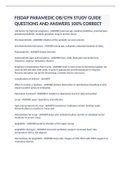FISDAP PARAMEDIC OB/GYN STUDY GUIDE QUESTIONS AND ANSWERS 100% CORRECT
risk factors for high risk pregnancy - ANSWER maternal age, medical conditions, preeclampsia, gestational diabetes, multiple gestation, drug or alcohol abuse,
Chorioamnionitis - ANSWER infection of the amniotic sac and contents
Chorioamnionitis risk factors - ANSWER young age, nulliparity, extended duration of labor,
Pyelonephritis - ANSWER kidney infection
pyelonephritis signs and symptoms - ANSWER fever, chills, flank pain and tenderness, frequency, urgency, hematuria, dysuria
pregnancy complications from trama - ANSWER mom is more prone to becoming hypoxic, lay mom on left side after 24th week, C-spine if appropriate and tilt backboard 15 degrees. Placenta abruption can be life threatening. Consider this for any trama.
complications of deilvery - ANSWER When to suction a newborn - ANSWER obvious obstruction to spontaneous breathing or who require positive pressure ventilation.
Meconium is present - ANSWER if newborn is depressed, insert et tube and suction
croup - ANSWER upper respiratory viral infection
signs and symptoms of croup - ANSWER hoarseness, inspiratory stridor, barking cough.
Primarily effects 6 months to 3 year olds
interventions for croup - ANSWER keep calm, nebulized saline, racemic or nebulized epi for moderate to severe croup.
epiglottitis - ANSWER bacterial infection of the upper airway
epiglottitis vital signs - ANSWER increased ventilatory support, increased heart rate, temperature 102 to 104 degrees.
interventions for epiglottitis - ANSWER keep calm, Oxygen at 94%. BVM with 100% oxygen if in respiratory distress signs and symptoms of epiglottitis - ANSWER typically occurs 2 to 7 years old.
sudden onset of fever. Quiet wet stridor, muffled voice, difficulty swallowing, tripod position, drooling, dysphasia, distress.
signs and symptoms of abuse and trama - ANSWER bruises at various stages of healing, burns, patterns of injury, unsafe, unusual, unsanitary conditions, behavior of those at scene.
causes of pediatric cardiac arrest - ANSWER primary apnea, secondary apnea, bradycardia, persistent fetal circulation, pulmonary hypertension
indications for pediatric cpr - ANSWER unresponsive, no breathing or only gasping, no pulse,
arrest rhythms - ANSWER asystole, PEA, VF, pulseless VT
hypovolemia - ANSWER most common type of shock in kids,
signs of compensated shock - ANSWER irritability, anxiety, tachycardia, tachypnea, delayed cap refill, cool pale extremities, decreased urine output, normal BP
signs of decompensated shock - ANSWER lethargy, altered mental status, marked tachycardia or bradycardia, absent peripheral pulses, cool pale dusky mottled extremities, hypotension, decreased urine output
common signs of meningitis in kids over 2 years - ANSWER high fever, headache, stiff neck called nuchal rigidity,
common signs of meningitis in newborns - ANSWER poor feeding, decreased activity, irritability,
bulging fontanel,
appendicitis - ANSWER loss of appetite, abdominal swelling, nausea and vomiting, dull pain near navel or upper abdomen that becomes sharp as it moves to the lower right.
bronchiolitis - ANSWER inflammation of smaller bronchioles caused by virus. RSV is the primary cause.
bronchiolitis physical examination - ANSWER low grade fever, runny nose and sore throat, wheezing if worse, tachypnea and tachycardia often present.
bronchiolitis intervention - ANSWER keep calm and oxygen,
pneumonia - ANSWER inflammation and infection of the lower airway and lungs caused by virus, bacteria, fungal, or parasitic.




